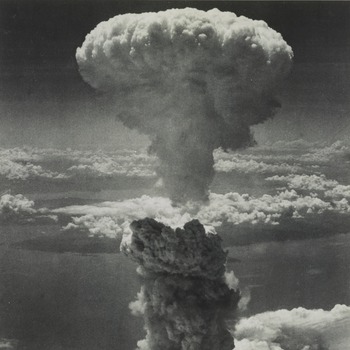-
August 6, 2025By Tanya Connor
The Catholic Free Press
with OSV and CNA reports
Worcester Catholics are among those calling for nuclear disarmament through commemorations of the 80th anniversary of the United States atomic bombings in Japan – in Hiroshima Aug. 6 and Nagasaki Aug. 9.
Local commemorations were to include survivors’ reflections, talks, cultural performances and church bell ringing. Other local Catholics are joining U.S. church leaders in Japan for a pilgrimage.
The local commemorations and the group joining the pilgrimage were organized by the Hiroshima Commemoration Project, an initiative of the Center for Nonviolent Solutions, said the center’s program director, Claire Schaeffer-Duffy, a member of St. Peter Parish and co-founder of the Saints Francis and Therese Catholic Worker House, both in Worcester.
The center, a non-profit organization aimed at helping people in the Worcester area with peace-building, is supported by the Catholic Worker house and First Unitarian Church in Worcester.
“The Hiroshima and Nagasaki anniversaries have historically been occasions for Americans to renew their commitment to work for nuclear disarmament,” said Ms. Schaeffer-Duffy. “That commitment is more urgent than ever as we reckon with a world destabilized by multiple conflicts, climate change, and AI-reliant warfare. ... We hope our commemorations animate a nuclear disarmament movement, one that pushes for the U.S. to sign on to the U.N. Treaty on the Prohibition of Nuclear Weapons.” She noted that the Vatican was among the first states to ratify this treaty.
On Aug. 6, the anniversary of the bombing of Hiroshima, a commemoration called “Cranes and Chorus: A Communal Call for Nuclear Disarmament” was scheduled for 6:30-8:30 p.m. at the Regatta Point area of Quinsigamond State Park, 10 North Lake Ave., Worcester.
The program was to include readings of reflections by Hiroshima survivors, cultural performances from the Massachusetts Japanese drumming group Mountain River Taiko and Worcester’s newly created Peace Chorus, remarks from U.S. Rep. James P. McGovern and Massachusetts Rep. Mary S. Keefe about present-day nuclear dangers, a Japanese candle floating ceremony for the dead and distribution peace cranes.
At 11:02 a.m. on Aug. 9, Worcester churches are scheduled to toll their bells 80 times in remembrance of when Nagasaki was bombed. The churches include St. Paul Cathedral, St. Peter Parish, St. John Parish, Our Lady of Providence Parish at St. Bernard Church and First Unitarian Church.
Also on Aug. 9, a new bell in Nagasaki’s Immaculate Conception Cathedral (called Urakami Cathedral after the district where it was built) is to be rung for the first time.
Among those expected to be there to hear it are Ms. Schaeffer-Duffy and fellow St. Peter’s parishioners Charlie Washburn and Frances Anthes, and Mihoko Wakabayashi, a Japanese Worcester resident traveling with them.
They were to join others, including Cardinal Blase Cupich of Chicago; Cardinal Robert McElroy of Washington, D.C.; Archbishop Paul Etienne of Seattle; and Archbishop John C. Wester of Santa Fe, New Mexico, on a pilgrimage coordinated by the Partnership for a World Without Nuclear Weapons.
Archbishop Peter Michiaki Nakamura of Nagasaki and Bishop Alexis Mitsuru Shirahama of Hiroshima worked with the U.S. archdioceses to sponsor the pilgrimage, which is also being supported by U.S.-based Catholic universities and Japanese universities.
The pilgrimage centers on the jubilee year theme: “Pilgrims of Hope.”
It was scheduled to include Mass, dialogue about Catholic ethics and nuclear weapons, ecumenical dialogue, and visits to historical sites and museums. Catholic bishops from Japan, South Korea, and the U.S. were to join bomb survivors for a panel discussion.
The bell to be rung at Urakami Cathedral is a gift from Catholics in the U.S., whose country’s atomic bomb destroyed this Catholic church and one of its two bells on Aug. 9, 1945.
The bomb detonated nearby, killing more than 70,000 people, including about 8,500 of the cathedral’s 12,000 parishioners. Many died instantly, and others died from the lingering effects of radiation. The U.S. launched this attack, and the one on Hiroshima on Aug. 6, 1945, to force the unconditional surrender of Japan and hasten the end of the Second World War.
Dr. Takashi Nagai, a Nagasaki Catholic physician and radiologist injured and widowed by the bomb, encouraged fellow Catholics to search in the ruins for a bell that had called them to prayer. One bell was damaged and unusable. The other bell was intact and rung on Christmas Eve in 1945.
A new Urakami Cathedral was rebuilt and dedicated in 1959 on that site, with that original bell in one tower, and the other tower without a bell.
In his book “The Bells of Nagasaki,” Dr. Nagai urged people to oppose war and work together. He spoke at a 1945 Mass for bombing victims, noted the history of persecuted Nagasaki Christians’ faith over the centuries, and contended that the deaths of so many Catholics in the bombing could be seen as a sacrifice to God for peace. (Last year Nihon Hidankyo, a Japanese atomic bomb survivors’ organization, received the Nobel Peace Prize.)
Inspired by Dr. Nagai’s story and a Japanese Catholic’s suggestion, James L. Nolan Jr. led the Nagasaki Bell Project to have American Catholics donate a bell to replace the ruined one.
Professor Nolan, an author doing research in Japan and who is the Washington Gladden 1859 professor of sociology at Williams College in Williamstown, Massachusetts, is in Japan for the ringing of that bell Aug. 9, said Scott Schaeffer-Duffy, Ms. Schaeffer-Duffy’s husband. Professor Nolan’s grandfather was the chief medical officer at the Los Alamos, New Mexico, facility where the atomic bomb was developed and he went to Hiroshima and Nagasaki with a survey team after the bombings.
Professor Nolan reported that 628 individual donations raised $125,000 in about one year and four months for the bell project.
– More information is available at hiroshimacommemoration.my.canva.site/.

